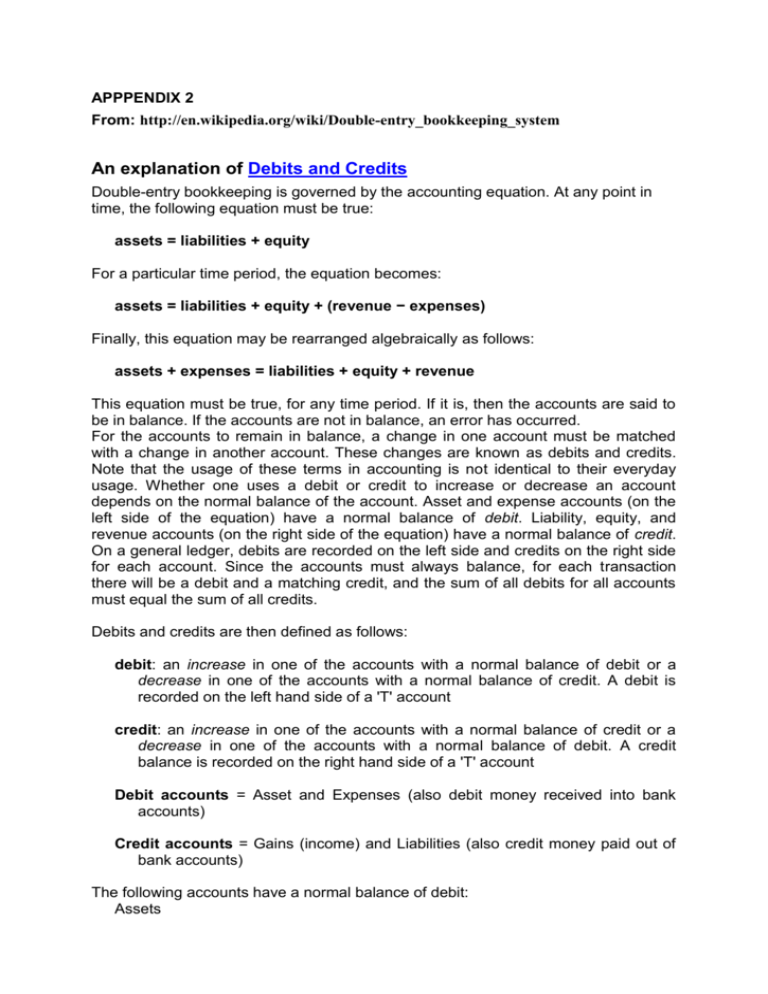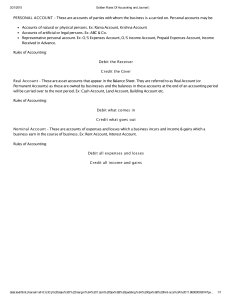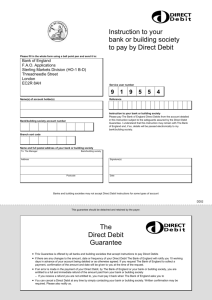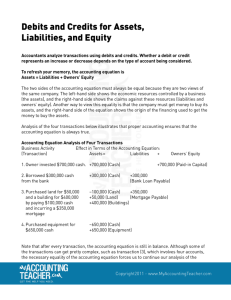Debit and credit
advertisement

APPPENDIX 2 From: http://en.wikipedia.org/wiki/Double-entry_bookkeeping_system An explanation of Debits and Credits Double-entry bookkeeping is governed by the accounting equation. At any point in time, the following equation must be true: assets = liabilities + equity For a particular time period, the equation becomes: assets = liabilities + equity + (revenue − expenses) Finally, this equation may be rearranged algebraically as follows: assets + expenses = liabilities + equity + revenue This equation must be true, for any time period. If it is, then the accounts are said to be in balance. If the accounts are not in balance, an error has occurred. For the accounts to remain in balance, a change in one account must be matched with a change in another account. These changes are known as debits and credits. Note that the usage of these terms in accounting is not identical to their everyday usage. Whether one uses a debit or credit to increase or decrease an account depends on the normal balance of the account. Asset and expense accounts (on the left side of the equation) have a normal balance of debit. Liability, equity, and revenue accounts (on the right side of the equation) have a normal balance of credit. On a general ledger, debits are recorded on the left side and credits on the right side for each account. Since the accounts must always balance, for each transaction there will be a debit and a matching credit, and the sum of all debits for all accounts must equal the sum of all credits. Debits and credits are then defined as follows: debit: an increase in one of the accounts with a normal balance of debit or a decrease in one of the accounts with a normal balance of credit. A debit is recorded on the left hand side of a 'T' account credit: an increase in one of the accounts with a normal balance of credit or a decrease in one of the accounts with a normal balance of debit. A credit balance is recorded on the right hand side of a 'T' account Debit accounts = Asset and Expenses (also debit money received into bank accounts) Credit accounts = Gains (income) and Liabilities (also credit money paid out of bank accounts) The following accounts have a normal balance of debit: Assets Accounts receivable: debts promised by other entities but not yet paid Drawings by the owners on equity Expenses Losses (that is, when expenses exceed revenue) The following accounts have a normal balance of credit: Liabilities Accounts payable and taxes, notes or loans payable: debts promised to outsiders but not yet paid Revenue Profit (that is, when revenue exceeds expenses) Examples of debits and credits: Purchase of a Computer Debit = Computer A/c (Fixed Asset A/c) Credit = Creditors A/c (Liability A/c) Paying supplier for the computer Debit: Creditors A/c (Liability A/c) You are reducing a Liability A/c Credit: Bank A/c (Asset A/c) Money going out, you are reducing an asset account Credit and debit items are summarised at the end of a recording period in a trial balance which is a list of all the debit and credit balances. The trial balance acts as a self checking mechanism for the correctness of entries in the individual accounts and also as a starting point for the preparation of the Final Account which is made up of the balance sheet and the trading, profit and loss account. The following table summarizes the basic accounts. A "+" indicates an increase; a "−" indicates a decrease. Debit/Credit Account Debit Credit Assets + − Liabilities − + Shareholder Equity − + Revenue (−) + Expenses + (−)






